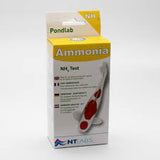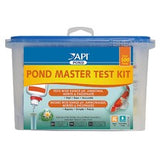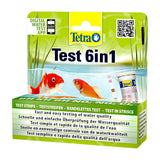NT Labs Pond Test Kits
Ammonia is invisible to the naked eye and its presence or absence cannot be determined by looking at the water alone. It is extremely toxic to the fish but is broken down into less toxic nitrite by the beneficial bacteria found in the filter. Ammonia is excreted by the fish as waste product. A high level of Ammonia is an indicator of poor biological filtration, and in time this will cause major health problems, so it is important to test regularly.
There is no occasion where any ammonia is tolerable. A level of zero mg/l (ppm) should be maintained at all times.
NT Labs have redesigned their popular range of test kits and have condensed the ranges into one to make shopping for their test kits even easier!
Testing Pond Water:
If a level of 0.2 mg/l (ppm) is found, add a filter booster such as Filter Bugs. If a level above this is found, then a substantial water change is essential. Change 25% of the volume for 0.5 - 1.0 mg/l (ppm) ammonia and 50% for ammonia levels above this. Add Zeolite to the filter compartment to remove ammonia. If any amount of ammonia is found, then it is important to check other vital water quality parameters, in particular pH, KH and nitrite.
Nitrite is produced by beneficial filtration bacteria as they break down the harmful waste ammonia excreted by the fish. Like ammonia, it is not visible to the naked eye. Although it is not as toxic as ammonia, nitrite is still very damaging to the health of the fish. Nitrite itself is broken down into nitrate, which is practically harmless to fish.
There is no occasion where any nitrite is tolerable in an aquarium. A level of zero mg/L (ppm) should be maintained at all times.
NT Labs have redesigned their popular range of test kits and have condensed the ranges into one to make shopping for their test kits even easier!
Testing Pond Water:
If 0.25 - 0.5 mg/l (ppm) of nitrite is found, then add Filter Bugs. If a level above this is recorded, then a substantial water change is essential. Change 25% of the water volume for 1 mg/l (ppm) nitrite and 50% for nitrite levels above this. If any level of nitrite is detected Zeolite will remove ammonia (and thus nitrite) from the water and can be recharged. If you do record a nitrite level, then it is important to check other vital water quality parameters, especially pH and ammonia.
Nitrate is produced by the beneficial bacteria in the water and filters as they break down the fish's toxic waste products (ammonia and nitrite). Nitrate is not typically toxic to fish, but excessively high levels (>100mg/l) can cause problems with growth.
The level of nitrate is dependent upon a number of factors, including the nitrate level of the tap water (or spring water etc) feeding into the aquarium, the number of fish and the amount of food fed. High nitrate levels will lead to algal growth. A nitrate level of zero is ideal and implies a balance between waste produced by the fish and nutrients taken up by the plant life. Remember: this plant life does include algae.
NT Labs have redesigned their popular range of test kits and have condensed the ranges into one to make shopping for their test kits even easier!
Testing Pond Water:
Maintenance of a zero level of nitrate is extremely difficult. Most domestic water supplies have a low level of nitrate. The key to maintenance of low nitrates is regular water changes to dilute the build up of nitrate.
There is no definitive correct pH as different fish species have their preferred pH range. Generally, the ideal pH value will lie between 7 and 8, but there are some exceptions. When purchasing fish from your local aquatic retailer, always make sure you know the specific water requirements of the fish you are buying.
Testing Pond Water:
If you do need to adjust the pH of your pond, it is vital to do this slowly to not shock the fish. Change no more than 0.5 pH units per 2 days. Providing your tap water is of suitable pH, substantial water changes can correct a dangerous pH level. It is also important to check the KH of the pond. Use of pH adjusters, such as KH - Buffer Up will raise the pH caused by soft or aged water. For fish that live in soft, acid water use bogwood to gently lower the pH and soften the water.
Hardness Test Kit
What is KH?
KH, also known as “total alkalinity” or “carbonate hardness”, is a measure of the buffering capacity of the water in your aquarium. The buffering capacity refers to how well it can resist changes in pH.
What is GH?
General Hardness is a measure of the total amount of minerals dissolved in the water. Water hardness lies on a spectrum between ‘soft water’ or ‘hard water’ depending on the amount of dissolved minerals: the more minerals present, the greater the hardness. Hard water is responsible for the build-up of limescale.
KH in detail:
What is the correct KH level?
This test kit measures KH in dKH (where one dKH = 17.8 ppm as CaCO3). It is essential to maintain a minimum KH level of at least 4 dKH at all times. A KH of between 6 and 8 dKH is more desirable.
How to use?
- Ensure the test tube is clean.
- Take a 5 ml sample of water into the test tube.
- Take the KH reagent and add one drop, mix and the water sample should turn pale blue.
- Keep adding drops, one by one (remember to count the drops), mixing between drops, until the blue colour turns to yellow. The number of drops, including the first drop, needed to bring about the colour change is equal to the KH value in dKH. Should the first drop of reagent turn the sample yellow then the KH value is below 1 dKH – this is extremely dangerous for fish.
GH in detail:
What is the correct GH level?
This test kit measures GH in dGH (where one degree = 17.8 ppm as CaCO3). The correct GH depends on the type of fish being kept. For soft water species, aim for a GH of around 3 to 6 dGH, while for hard water species, 10 to 15 dGH is the correct range.
How to use?
- Ensure the test tube is clean.
- Take a 5 ml sample of water into the test tube.
- Take the GH A reagent and add two drops.
- Mix and the water sample should turn dark pink. Adding one drop of reagent GH B at a time, mixing between drops, count the number of drops required for the solution to change from pink to blue.
- The number of drops needed to bring about the colour change is equal to the GH value in dGH. Should the first drop of GH B reagent turn the sample blue then the GH value is below 1 dGH and indicates very soft water.
We Also Recommend








